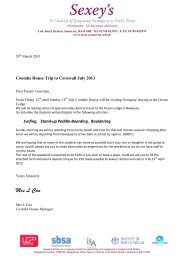Untitled - Sexey's School Moodle
Untitled - Sexey's School Moodle
Untitled - Sexey's School Moodle
Create successful ePaper yourself
Turn your PDF publications into a flip-book with our unique Google optimized e-Paper software.
As a reaction to this “democratization,” which cultural authorities perceived as an<br />
unregulated expansion of undisciplined readers, literary criticism became a figure of<br />
authority in the process of establishing taste and setting value, and determined the<br />
boundaries between high and low culture, between what was considered popular writing<br />
and “serious” literature. This sparked the view that great Art was inversely proportional<br />
to popularity by incorporating the particular issues of audience and readership—and<br />
specifically as they relate to gender and class—within the cultural discourses of critical<br />
reception and canon-formation. As Guillory points out, this trend also triggered a clear<br />
tendency to establish hierarchies amongst genres as championed by Wordsworth and<br />
Coleridge; poetry, for example, was given “unquestioned generic superiority” (Cultural<br />
Capital 131). In sum, institutional authorities, such as critics and teachers, played an<br />
essential role in reviewing and criticizing literature. In doing so, they were determining<br />
which works should be read and how, as well as arguing for the importance of having a<br />
literary canon.<br />
Two interrelated conceptualizations dominated canon-formation practices up to<br />
the late eighteenth century: the Platonic ideal that literature should serve moral and social<br />
functions and Horace’s notion that literature should “instruct and delight.” Chapter One<br />
outlined how Plato carefully selected which texts would teach the citizens of the republic<br />
the best examples of civil and moral conduct. The same criteria were used when the<br />
process of canonization involved the decision of which books should be included in the<br />
Bible by reflecting the standards of moral conduct and social behavior that the<br />
ecclesiastic authorities had set in the community. Through the ensuing periods, Plato’s<br />
ideology was coupled with the Horatian paradigm in the critical works of authors such as<br />
97



